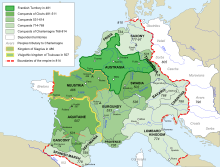
Back Boergondië Afrikaans Бургундия Bulgarian Burgund Danish Burgundische Geschichte German Historia de Borgoña Spanish Burgundia ajalugu Estonian Histoire de la Bourgogne French Sejarah Bourgogne ID Storia della Borgogna Italian Burgund NB


The history of Burgundy stretches back to the times when the region was inhabited in turn by Celts, Romans (Gallo-Romans), and in the 5th century, the Roman allies the Burgundians, a Germanic people perhaps originating in Bornholm (Baltic Sea), who settled there and established the Kingdom of the Burgundians.
This Burgundian kingdom was conquered in the 6th century by another Germanic tribe, the Franks, who continued the kingdom of Burgundy under their own rule.
Later, the region was divided between the Duchy of Burgundy (to the west) and the County of Burgundy (to the east). The Duchy of Burgundy is the better-known of the two, later becoming the French province of Burgundy, while the County of Burgundy became the French province of Franche-Comté, literally meaning free county.
The situation is complicated by the fact that at different times and under different geopolitical circumstances, many different entities have gone by the name of 'Burgundy'. Historian Norman Davies has commented that "[f]ew subjects in European history have created more havoc than that summarized by the phrase 'all the Burgundies'." In 1862, James Bryce compiled a list of ten such entities, a list which Davies himself extends to fifteen, ranging from the first Burgundian kingdom founded by Gunther in the fifth century, to the modern French région of Burgundy.[1]
- ^ Norman Davies, Vanished Kingdoms, 2011, Penguin (2012) pp. 90-143.